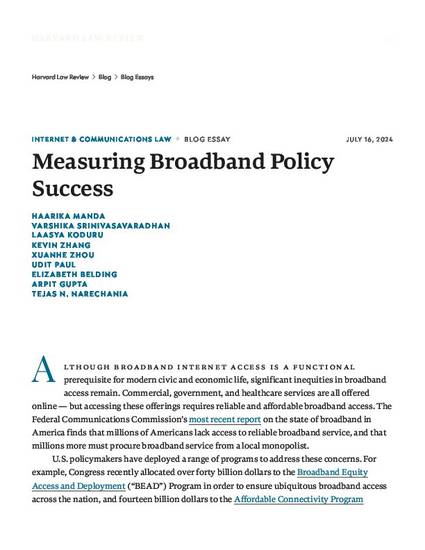
Article
Measuring Broadband Policy Success
Harvard Law Review Blog
(2024)
Abstract
Although broadband internet access is a functional prerequisite for modern civic and economic life, significant inequities in broadband access remain. Commercial, government, and healthcare services are all offered online — but accessing these offerings requires reliable and affordable broadband access. The Federal Communications Commission’s most recent report on the state of broadband in America finds that millions of Americans lack access to reliable broadband service, and that millions more must procure broadband service from a local monopolist.
U.S. policymakers have deployed a range of programs to address these concerns. For example, Congress recently allocated over forty billion dollars to the Broadband Equity Access and Deployment (“BEAD”) Program in order to ensure ubiquitous broadband access across the nation, and fourteen billion dollars to the Affordable Connectivity Program (“ACP”) to address affordability-related concerns (though ACP’s funds have since been depleted, forcing the FCC to wind-down the program).
Before BEAD, the Federal Communications Commission (“FCC”) allocated over ten billion dollars to the Connect America Fund (“CAF”), a similar program aimed at ensuring broadband access in underserved areas, with a particular focus on rural areas. Specifically, the FCC offered CAF subsidies to internet service providers (“ISPs”) in exchange for deploying broadband infrastructure: A single ISP was eligible for the subsidy in each region without broadband access, and ISPs accepting the subsidies were required to satisfy certain regulatory obligations, including speed and cost requirements.
Given the scale and importance of policy interventions like CAF and BEAD, it is critical to assess their efficacy. Effective program review can help policymakers both evaluate the success of these programs and design new and better policy interventions that tackle our nation’s stubborn digital divide. In a peer-reviewed study, accepted to the 2024 ACM SIGCOMM Conference, we take one initial but substantial step in this direction. We find that the serviceability rate — i.e., the weighted fraction of CAF-funded addresses that are actually served by subsidized ISPs — is only 55 percent, dropping to as low as 18 percent in some states. Moreover, the compliance rate — i.e., the weighted fraction of CAF-funded addresses where ISPs offer service that satisfies the FCC’s program rules — is only 33 percent. In short, over two-thirds of addresses “certified” as served by the ISPs do not, in fact, appear to receive service that meets the FCC’s program rules.
These results offer an important measure of the extent to which ISPs have lived up to their promises under CAF, and the extent to which CAF has helped improve broadband access in its target regions. So long as policymakers continue to allocate funds to improve broadband access nationwide, empirically grounded analysis of these programs remains critical. Regulators should interrogate ISPs’ service claims, improve audit transparency, and implement stringent requirements to ensure better service quality and consumer value. And officials might even consider past compliance with funding programs when deciding how to award subsidies in the future.
Keywords
- Connect America Fund,
- broadband,
- subsidies,
- broadband deployment,
- FCC,
- universal service
Disciplines
Publication Date
July 16, 2024
Citation Information
Haarika Manda, Varshika Srinivasavaradhan, Laasya Koduru, Kevin Zhang, Xuanhe Zhou, Udit Paul, Elizabeth Belding, Arpit Gupta, Tejas N. Narechania, Measuring Broadband Policy Success, Harvard Law Review Blog (July 16, 2024)
